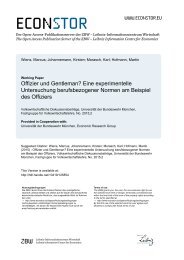DISCUSSION
n?u=RePEc:iza:izadps:dp10283&r=exp
n?u=RePEc:iza:izadps:dp10283&r=exp
Create successful ePaper yourself
Turn your PDF publications into a flip-book with our unique Google optimized e-Paper software.
to those for performance-based goals in Section 4.2.1. The formal results and proofs are relegated<br />
to Supplementary Web Appendix III.2. The three relevant thresholds now become:<br />
a = βδθ<br />
κ ; â = δθ κ<br />
> a; a =<br />
βδθ + λ<br />
κ<br />
> a. (9)<br />
Mirroring Remark 1, in the absence of a goal the student exhibits time inconsistency: the<br />
student-actor chooses effort a, which is smaller than the student-planner’s desired level of effort<br />
â. The upper bound on student-actor effort in the presence of a goal is given by a. Mirroring<br />
Proposition 1, this upper bound increases as the time-inconsistency problem becomes less severe<br />
(higher β) and as the strength of goal disutility λ goes up. Mirroring Proposition 2, the optimal<br />
choice of goal for the student-planner is given by g ∗ = min{â, a} and the optimal goal induces<br />
the student-actor to exert effort a ∗ = g ∗ > a; once again, the optimal goal induces the student<br />
to work harder than she would in the absence of a goal and the student always achieves her goal<br />
in equilibrium. When βδθ + λ ≥ δθ, â ≤ a, and so the student-planner achieves her desired level<br />
effort by setting g ∗ = â. Just like in Proposition 2, this case holds when the time-inconsistency<br />
problem is not too severe (high β) or the strength of goal disutility λ is sufficiently high.<br />
4.3 Why were task-based goals more effective than performance-based goals?<br />
The baseline model outlined in Section 4.2 suggests that goal setting can improve course performance.<br />
Our experimental data show that task-based goals are more effective at raising students’<br />
performance than performance-based goals (Tables 3 and 6), and that task-based goals are more<br />
frequently achieved than performance-based goals (Table 2). 32 Using the framework of the<br />
baseline model, we now consider three possible explanations for why task-based goals are more<br />
effective than performance-based goals (we view these explanations as complementary).<br />
4.3.1 Overconfidence<br />
We start by relaxing the strong assumption made in the baseline model that students understand<br />
perfectly the relationship between effort and performance. Suppose instead that some students<br />
are overconfident. An overconfident student believes that the production function is given by<br />
f(·), when in fact performance is given by h(·) with h(·) < f(·). Such overconfidence could<br />
be driven by a student’s biased beliefs about her ability level, by incorrect beliefs about the<br />
difficulty of the course or by overconfidence about the productivity of the tasks that the student<br />
chooses to work on. 33<br />
32 It is possible that some students in the Control group (who were not invited to set goals) might already<br />
use goals as a commitment device. However, since we find that task-based goals are successful at increasing<br />
performance, we conclude that many students in the Control group did not use goals or set goals that were<br />
not fully effective. We note that asking students to set goals might make the usefulness of goal setting as a<br />
commitment device more salient and so effective. Reminding students of their goal, as we did, might also help to<br />
make them more effective.<br />
33 The education literature supports the idea that students face considerable uncertainty about the educational<br />
production function, and that this uncertainty could lead to students holding incorrect beliefs about the performance<br />
impacts of particular tasks (e.g., Romer, 1993, and Fryer, 2013). Furthermore, the broader behavioral<br />
literature shows that people tend to be overconfident when they face uncertainty (e.g., Weinstein, 1980, Camerer<br />
and Lovallo, 1999, and Park and Santos-Pinto, 2010), while also providing a number of theoretical underpinnings<br />
for overconfidence (e.g., Brunnermeier and Parker, 2005, Johnson and Fowler, 2011, and Gossner and Steiner,<br />
2016).<br />
25




